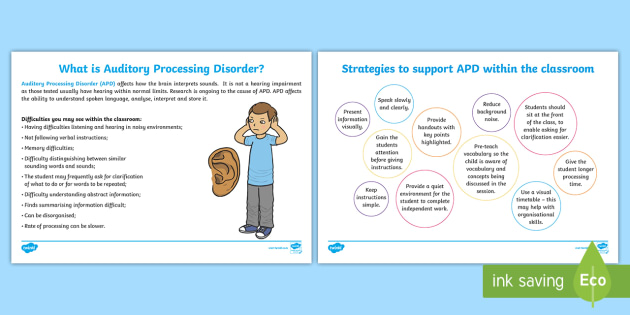

Frequency-modulated (FM) listening devices can also help the wearer better understand speech in noisy environments – these use a microphone and receiver to help deliver sounds directly to the wearer’s ears. For example, assistive remote microphone devices can help improve the clarity of sounds (rather than increasing volume, as a standard hearing aid might). Learning to predict potential elements of a conversation, using visual aids, incorporating memory techniques like mnemonic devices, and practicing active listening techniques can also help people get around their ADP, leading to better understanding and communication.Īssistive listening devices may also provide relief for auditory processing disorder symptoms, although specific advanced technology is needed. People with APD can also learn certain ‘workaround’ strategies that compensate for the areas that are a cause for concern – for example, strengthening memory, attention and problem-solving skills. These might be done using computer programs, or it can be in-person or online training, and involves tasks that help people with things like learning to distinguish between similar speech sounds (like b and p in rhyming words, such as buy and pie), identifying the direction sounds are coming from and more.⁹

Sounds may be garbled or fragmented, like listening to someone on a phone whose reception is dropping in and out.Īlthough APD is considered a lifelong condition, it can be managed with various tools and techniques that ease auditory processing disorder symptoms.⁷ While every person with APD needs a personalised management plan, a combination of auditory training, environmental changes and assistive hearing technology is a commonly used approach to help people with APD to better understand the sounds around them.⁸Īuditory training involves a person with APD practicing exercises that target the specific issues they’re facing.

When living with an auditory processing disorder, adults often say they can hear but can’t understand what they’re hearing. At work, you may not notice your phone ringing, have trouble following complex directions or recognising how someone is feeling by their tone.

Out and about, you may have trouble hearing what friends are talking about when you go to a café or bar or struggle to hear speech in a crowded supermarket.
#APD DISORDER IN ADULTS TV#
Other symptoms may include having trouble following spoken directions unless they are brief and simple, and attending to and remembering spoken information difficulty processing spoken information sensitivity to loud sounds poor listening skills an inability to differentiate tone of voice or other nuances of speech.Īt home, this might look like turning the TV volume up very loud but still not being able to understand what’s happening on the screen or being accused of ‘not paying attention’ to a family member or housemate’s requests. Difficulty understanding speech in noisy environments, for example, being overwhelmed by a lot of background noise, not knowing where a sound is coming from or frequently having to ask people to repeat themselves, are common auditory processing disorder symptoms.³ Many early signs and symptoms of an auditory processing disorder in adults are similar to symptoms of hearing loss due to other causes.


 0 kommentar(er)
0 kommentar(er)
